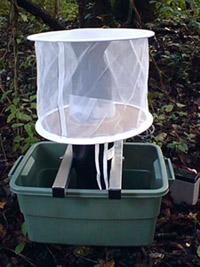 |
| Gravid traps are designed to attract and collect egg-bearing mosquitoes found near water with a high organic content (polluted water). Female Culex mosquitoes which have already fed are more likely to be infected with a virus, and are thus better specimens to test for West Nile virus. |
 |
In 2003, the highest light trap total was an estimated 21,329 mosquitoes obtained from a trap located in the Fire Island Wilderness Area. In 2004, this location netted a "highest" figure of 9,620 mosquitoes, and in 2005, it yielded 10,491 mosquitoes on August 29. The highest single day count for 2006 was more than three times that amount! On the night of September 17, 2006, a CDC Light Trap in Hospital Point (Wilderness Area) collected an estimated 54,000 mosquitoes. Given that our trapping periods are about 16 hours, this calculates to a rate of 3375 per hour, 56 per minute or about 1 per second!
The highest gravid trap total in 2007 was obtained from the Watch Hill West trap (about 5,425 mosquitoes on 6/25/2007). The average for this site was 85 mosquitoes, while the Fire Island Lighthouse gravid trap average was 12, Sunken Forest was 7, Fire Island Pines was 5, Wilderness Visitor Center was 14, and the William Floyd Estate averages were 14 and 28.
Of the 40 species of mosquitoes recorded in Suffolk County, at least 25 different species have been found within Fire Island National Seashore.
The park also monitors for dead birds (especially crows, jays, raptors, and now robins), vector carrier species which may have died because of WNV. The results of the monitoring program help the park determine management actions. Criteria in the mosquito surveillance protocols dictate the proper steps to take in handling potentially infected carrier animals (dead birds), notifying the public about potential hazards, and authorizing spraying for mosquitoes or closing areas of the park to the public.
Until 2007, evidence of WNV-infected mosquitoes had been detected within the boundaries of the park every year since 2000, when it was detected in the community of Saltaire. In 2001 it was detected at Watch Hill. In 2002 it was detected again at Watch Hill (near the border of the Davis Park community) and in the Wilderness Area. In 2003, WNV was isolated from William Floyd Estate mosquitoes, and the park’s first WNV positive bird was also collected in the community of Cherry Grove. In 2004, WNV was again detected at the William Floyd Estate. In 2005, positive samples of Culex mosquitoes were discovered in the Village of Saltaire, in the Sunken Forest, at the Lighthouse Tract, and at Hospital Point in the Fire Island Wilderness. After Labor Day in 2006, a single sample tested positive near Watch Hill, triggering additional testing which turned up no additional positive samples.
Interestingly, two mosquito-borne viruses that are new to the park have been detected in the past few years. Cache Valley Virus, found in 2003 at Watch Hill, is pathogenic to livestock and is not thought to infect humans. Flanders Virus, detected in 2004 and 2005 at the William Floyd Estate, is not known to infect any mammal.
Because of its effect on the environment, especially on fisheries and water quality, spraying is the action of last resort. However, after consultation with the Center for Disease Control (CDC) and the USGS Research Center, the park may authorize spraying when specified levels of infection are detected.
|






